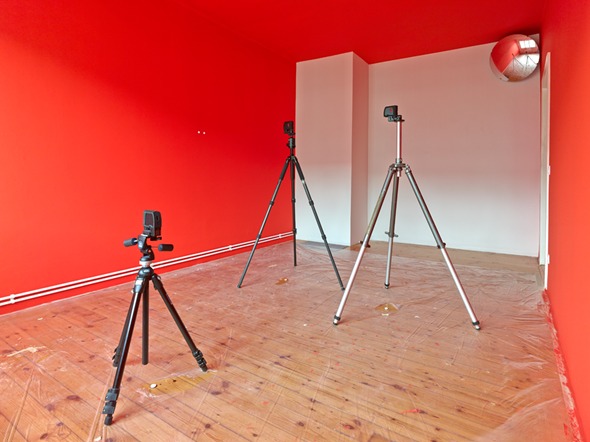Enough with end of the year best/worst rankings once again. There will always be more art than we can digest, shortening our attention spans, and causing our opinions to soften, broaden, become more compromising. The critic of exuberant homages and vitriolic damnings fades into the shadows, and who appears in their place? Not an apathetic voice, but a conflicted voice. Deconstructed and self-conscious yet loud and clear, and firmly present. Six curators and critics were invited to recall an exhibition that neither seduced nor repelled them but left them with an ambiguous verdict.
Contributors
Timo Feldhaus, writer, Berlin
Piper Marshall, curator at the Swiss Institute, New York
Daniel Baumann, curator, Basel
John Beeson, art critic, Berlin
Krist Gruijthuijsen, director of Grazer Kunstverein, Graz
Sam Pulitzer »Nine Scarlet Eclipses for ›Them‹«, Lars Friedrich, Berlin
Contributors
Timo Feldhaus, writer, Berlin
Piper Marshall, curator at the Swiss Institute, New York
Daniel Baumann, curator, Basel
John Beeson, art critic, Berlin
Krist Gruijthuijsen, director of Grazer Kunstverein, Graz

Installation view at Lars Friedrich, Berlin
Courtesy of the artist and Lars Friedrich, Berlin. Photo: Simon Vogel
With its self-leveling lasers tracing invisible limits from wall to wall and floor to ceiling, Nine Scarlet Eclipses for »Them« brilliantly formalized a scene of total surveillance and constant threat. But what’s the value in actually creating (or recreating) such an environment? Conceptually, the gesture has its justifications: cutting with a hot knife through a culture of affirmation and indifference, rupturing the status quo, effecting greater accountability by forcing the hand of transparency. But isn’t there also something insane about drawing lines in the sand and cracking down hard, about insisting on a divide between »us« and »them«?
These days, people all over have accepted the end of »us versus them« – accepted the impossibility of an »authentic« subculture according to old-world standards. But some are still searching for alternative holdouts, cultural producers just too hardcore or too niche to have been assimilated by dominant culture – or worse, co-opted. In part, that’s what Sam Pulitzer (*1984) is acting out by painting the gallery the same red color as the walls of a punk, hardcore, and metal record shop located in Brooklyn. The artist also lodged plastic ear gauges – the kind stretching holes in the earlobes of punk and emo fans at least since the early 2000s – into the gallery walls, floor, and ceiling. Though they supposedly defy societal norms – of beauty, self-expression, and common sense – their inclusion must be tongue-in-cheek: Ear gauges don’t convey the too-hardcore-to-be-assimilated narrative as convincingly as something or someone like Peste Noire, a borderline racist and nationalistic black metal band that both Mathieu Malouf and Nicolas Ceccaldi have referenced, to related ends.
This, then, is why I’m left conflicted (which was likely Pulitzer’s intention): His points of reference imply an ideology and a set of behaviors that he as good as reifies. But did he mean to critique them or celebrate them? Since I don’t know the answer, and since it would inform my judgment of Pulitzer’s reifications and formalizations, I can’t say whether I judge his exhibition positively or negatively. I can see its value, but still we might disagree on the question of procedure.
JOHN BEESON
These days, people all over have accepted the end of »us versus them« – accepted the impossibility of an »authentic« subculture according to old-world standards. But some are still searching for alternative holdouts, cultural producers just too hardcore or too niche to have been assimilated by dominant culture – or worse, co-opted. In part, that’s what Sam Pulitzer (*1984) is acting out by painting the gallery the same red color as the walls of a punk, hardcore, and metal record shop located in Brooklyn. The artist also lodged plastic ear gauges – the kind stretching holes in the earlobes of punk and emo fans at least since the early 2000s – into the gallery walls, floor, and ceiling. Though they supposedly defy societal norms – of beauty, self-expression, and common sense – their inclusion must be tongue-in-cheek: Ear gauges don’t convey the too-hardcore-to-be-assimilated narrative as convincingly as something or someone like Peste Noire, a borderline racist and nationalistic black metal band that both Mathieu Malouf and Nicolas Ceccaldi have referenced, to related ends.
This, then, is why I’m left conflicted (which was likely Pulitzer’s intention): His points of reference imply an ideology and a set of behaviors that he as good as reifies. But did he mean to critique them or celebrate them? Since I don’t know the answer, and since it would inform my judgment of Pulitzer’s reifications and formalizations, I can’t say whether I judge his exhibition positively or negatively. I can see its value, but still we might disagree on the question of procedure.
JOHN BEESON

Courtesy of the artist and Lars Friedrich, Berlin. Photo: Simon Vogel
